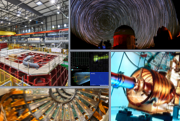Conveners
Collider Physics
- Sergo Jindariani (FNAL)
Dr
Douglas Berry
(University of Illinois at Chicago)
18/06/2018, 14:30
Oral Presentation
The LHC is the worlds highest energy proton-proton collider with a center-of-mass energy of 13 TeV. The world's largest machine is currently running at twice its designed luminosity and represents forefront of the energy frontier. The CMS detector is a multipurpose detector that features a 4 Tesla magnet and over a 100 million active channels taking data every 25 ns. It, along with its sister...
Hui Wang
18/06/2018, 14:45
Oral Presentation
My presentation is based on the analysis of searching for supersymetric particles, with the data collected by CMS detector in 2016, at a center-of-mass energy of 13 TeV and correspond to an integrated luminosity of 35.9 inverse fb. This analysis focuses on simplified SUSY models with top quarks and large missing transverse momentum in all hadronic final states. These channels have distinctive...
Mr
Orgho Neogi
(University of Iowa)
18/06/2018, 15:00
Oral Presentation
Coannihilation Codex is a classification of models for Dark Matter which lead to a variety of new signatures at colliders. One signature features a Dark Matter field as well as a new particle X and a Leptoquark. We are beginning a search which includes the first-generation leptoquark, leading to a signature with a high-pt electron, jets, and missing ET. We will show kinematic distributions and...
Prakash Thapa
(Wayne State University)
18/06/2018, 15:15
Oral Presentation
Non-resonant excesses in dilepton invariant mass spectra are predicted by several beyond the standard model (BSM) theories. In this search, two theoretical models, large extra dimensions (LED) and Compositeness are considered, and the status of the search in the mass range 400-5000 GeV will be presented using 2016 data collected by CMS detector. In LED, space-time is extended by an additional...
Mr
Wasikul Islam
(Oklahoma State University)
18/06/2018, 15:30
Oral Presentation
The efficient identification of jets from bottom quarks (b-jets) is one of the most important techniques for many physics analyses at the Large Hadron Collider, including studies of the Higgs boson, the top quark, and searches beyond the Standard Model. The performance is characterized by b-tagging efficiency (probability to identify a b-jet as such) and the mistag rate (probability to...
Mr
Guillermo Fidalgo
(University of Puerto Rico Mayaguez)
18/06/2018, 15:45
Oral Presentation
The Data Quality Monitoring (DQM) of CMS is a key asset to deliver high-quality data for physics analysis and it is used both in the online and offline environment. The current paradigm of the quality assessment is labor intensive and it is based on the scrutiny of a large number of histograms by detector experts comparing them with a reference. This project aims at applying recent progress in...
Ms
Bahareh Roozbahani
(suny Buffalo)
18/06/2018, 16:00
Oral Presentation
The High-Luminosity Large Hadron Collider (HL-LHC)
aims to increase luminosity by a factor of 10 beyond
the LHC's design value. To cope with the increased rate of particle
production without compromising physics performance, the LHC detectors
will undergo an extensive upgrade. CMS will replace the current inner
tracker system with a new silicon tracker which will feature...
